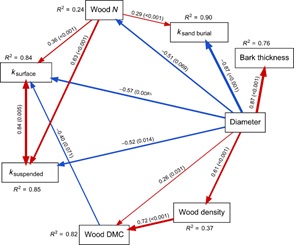
Wood decomposition within mesic temperate or tropical ecosystems is strongly modulated by biotic factors such as soil fauna and microbes due to their high abundances and activity at suitable environmental moisture regime. By contrast, lower vegetation canopy cover, that is, high irradiance, and lower annual precipitation could constrain decomposer abundances and activity in drylands. Therefore, there is accumulating evidence that litter decomposition in semi-arid and arid ecosystems is controlled by both biotic and abiotic factors.
Shrub encroachment, a common phenomenon in arid and semi-arid grasslands, affects soil carbon and nitrogen accumulation and turnover. Moreover, there exist many vegetation types in drylands in which woody plants are common and likely important to biogeochemical cycling, such as desert, inland dunes, semi-desert, woodland, shrubland and savanna. It is therefore surprising that research on woody debris decomposition in arid and semi-arid ecosystems is scarce.
Researchers from the Institute of Botany of the Chinese Academy of Sciences (CAS) and Vrije Universiteit Amsterdam investigated the relative importance of litter position (sand burial vs. surface vs. suspended above the surface), ultraviolet radiation, and stem diameter size on the mass loss of woody litters of four shrub species in an inland dune ecosystem in northern China.
They found that after 34 months of in situ incubation, decomposition rates of buried woody litters was three times faster than those of suspended and surface woody litters. This is quite different with mesic ecosystems that wood buried by soil, litter, or ground vegetation in wide-ranging forest ecosystems was efficiently preserved, i.e. slowly decomposed.
This implies that the effect of sand burial on wood decomposition strong depends on biomes with contrasting climate and associated soil taxa. This study demonstrates how wood decay differently in this dryland compared to mesic sites where, for instance, decay rates tend to be lower for buried wood. Considering the very important role for ultraviolet radiation of dryland leaf litter, this study reinforces how different plant tissues decay in very different ways.
The study entitled "Multiple abiotic and biotic drivers of long-term wood decomposition within and among species in the semi-arid inland dunes: A dual role for stem diameter" has been published in Functional Ecology.
The study was supported by the National Key Research and Development Program of China and CAS President's International Fellowship Initiative (PIFI).

The structural equation model (SEM) depicting pathways by which wood traits may influence k values in the semi-arid dune ecosystem. (Image by IBCAS)

86-10-68597521 (day)
86-10-68597289 (night)

52 Sanlihe Rd., Xicheng District,
Beijing, China (100864)

